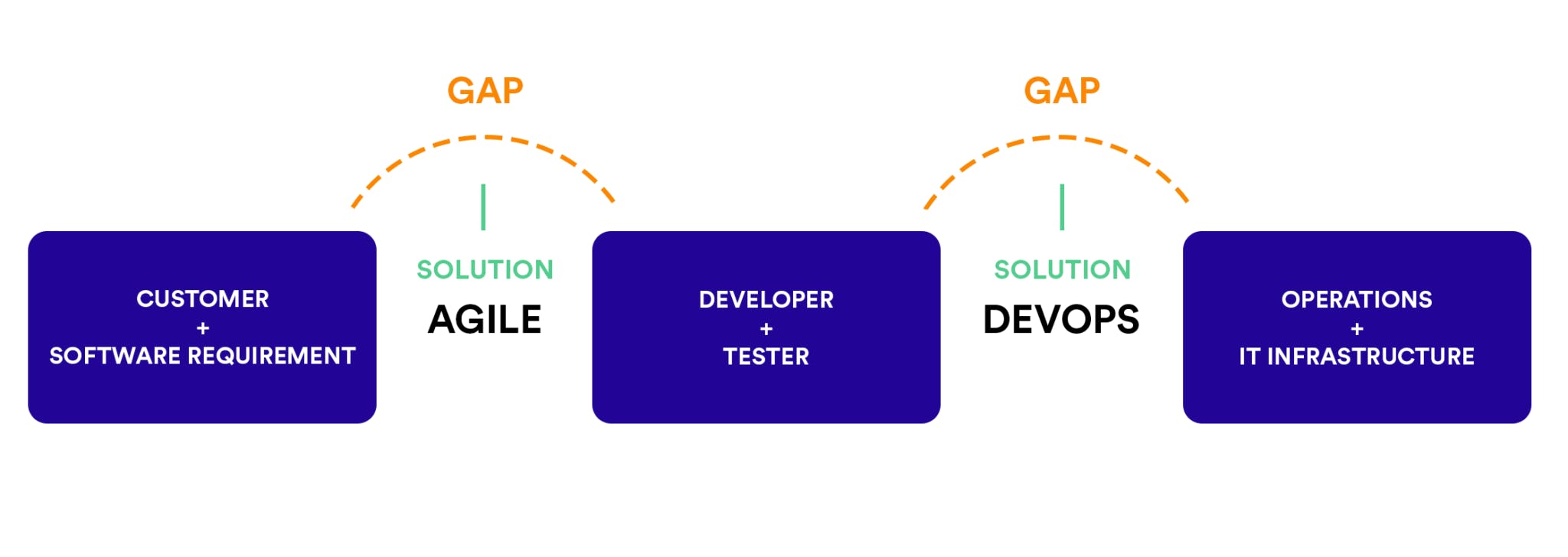If we think about the evolution of software development, we’ll distinguish 2 turning points: the introduction of the waterfall methodology and the shift towards the agile methodology.
Some will argue that the DevOps methodology is the next logical step in this evolutionary process. However, we’re here to show you that this DevOps vs Agile battle is not as straightforward as some may think.
DevOps didn’t emerge as a better alternative to Agile (like Agile appeared as an alternative to the waterfall methodology); instead, they can be used together.
In this article, we’ll debunk the enigmas behind these two buzzwords – Agile is not reduced to Scrum, just like DevOps is not only about Continuous Delivery. And we’ll do so by answering the following questions:
- What is Agile?
- What is DevOps?
- How are they alike?
- How do they differ?
- What happens when you use them together
Summary
- Short Intro to Agile
- Short Intro to DevOps
- Main Differences | DevOps vs Agile
- Main Similarities | DevOps vs Agile
- Using Both DevOps & Agile
- How Bunnyshell Can Help
Short Intro to Agile
Agile is a software development methodology that focuses on collaboration, organization, and feedback to deliver value to the end-customer faster and more efficiently. Development is carried out by smaller teams that work on a single feature at a time, with continuous testing and adjustments implemented as you go based on immediate customer feedback.
Agile can be implemented in many ways, but the most popular frameworks are Scrum, Kanban, Lean Development, and Feature-Driven Development.
Short Intro to DevOps
The DevOps model is a collection of practices and tools that enable teams to deliver applications and services more rapidly, frequently, and reliably. As Development and Operations are merged, engineers work across the entire application lifecycle.
Often, quality assurance and security teams work closely together with development and operations. When security becomes every team member’s priority, that’s called DevSecOps.
DevOps automates manual (and slow!) processes. Moreover, DevOps automation platforms enable engineers to accomplish tasks independently that would otherwise require help from other teams, which further improves the speed at which new features can be implemented.
Main Differences | DevOps vs Agile
| Agile | DevOps | |
|---|---|---|
| Philosophy | The team focuses on delivering small increments of a project. | Development and Operations teams collaborate to increase each other’s productivity. |
| Focus | Embracing frequent changes to improve quality. | Bringing together Development and Operations to ensure continuous development and testing. |
| Purpose | Managing complex projects. | Managing end-to-end engineering. |
| Goal | Bridging the gap between customer needs and the development & testing team. | Bridging the gap between development and testing teams & operations. |
| Focus | Functional and non-function readiness. | Operational and business readiness. |
| Emphasis | Developing software. | Deploying released software in a reliable and secure manner. |
| Automation | Doesn’t focus on automation. | Automation is the core of DevOps. |
| Delivery | Weekly or bi-weekly - incremental deployments after each sprint. | Weekly, daily, or even every few hours - focuses on continuous delivery. |
| Quality & risk | With each sprint, the quality of the product increases while the risk decreases. | The high-quality of a product is ensured by automated testing. |
| Team size | Small teams that can move fast. Team members have similar skill sets. | Large teams that consist of multiple departments (each stakeholder is involved). |
| Team skillset | Each team member has a wide variety of similar and equal skills. | Skillsets are spread between Development and Operations teams. |
| Feedback | Focuses on customer feedback. | Focuses on internal feedback. |
| Communication | Daily Scrum meetings. | Communication is complex and involves specs and design documents. |
| Documentation | Light documentation that allows for increased flexibility. | Sufficient documentation because the transfer of knowledge is difficult. |
| Shift-Left Principles | Leverages shift-left. | Leverages both shift-left and right. |
| Challenges | The team needs to be more productive. | Development, testing, and production environments need to be streamlined. |
| Advantages | Shorter development cycles. | It supports Agile’s release cycle. |
| Tools | JIRA, Git, Jenkins, Kanboard, Bugzilla, Active Collab, & more. | AWS, GitLab, Kubernetes, Docker, OpenStack, Puppet, Ansible, Chef, & more. |
| Manifestations | Continuous Integration, Continuous Delivery, Continuous Deployment | Scrum, Kanban, Lean Development, Feature-Driven Development, Extreme Programming. |
Main Similarities | DevOps vs Agile
Now that we’ve highlighted the DevOps vs Agile differences, it’s time to discuss the similarities between them:
- They both focus on collaboration: not matter which technique you choose to implement, sharing updates regarding the development process is vital. Therefore, DevOps and Agile have the same objective – enhancing collaboration.
- Their goal is to have a finished product: Agile focuses on having smaller but frequent releases with the goal of delivering a potentially finished product at the end of each sprint. DevOps focuses on Continuous Delivery, which means product updates are deployed up to several times a day. So for both approaches, products are almost always “finished”.
- They both implement Lean Philosophies: efficient collaboration starts with good communication. So, in order for the team to collaborate effectively, both Agile and DevOps keep the Lean Philosophy at their core.
- They both make use of automation: for Agile, automation helps free up human resources so the team can dedicate more time to research testing. On the other hand, automation is the core of DevOps which focuses on Continuous Integration. Without it, it would be almost impossible to ensure the products’ quality.
- They both lead to business productivity: Agile pushes DevOps to speed up, while DevOps pushes Agile to be more intensive. So, even though these two approaches are different, in the end, they help achieve the same goal. Which is why they work best together.
Using Both DevOps & Agile

As you can see, the idea with DevOps vs Agile is that they’re not mutually exclusive; instead, you can use them together to achieve greater efficiency and more reliable results.
Here’s what each practice can bring to the table:
- speed: DevOps helps Agile speed up the release cycle while also making releases more reliable
- efficiency: DevOps seeks to automate workflows wherever possible, driving increased efficiency
- productivity: planning tools such as Scrum and Kanban help organize requirements and tasks
- cadence: working in sprints ensures consistent development
- focus on the customer: relying on consistent feedback loops ensures the customers’ expectations stay top-of-mind during development.
This is why we recommend every company transitioning to DevOps not abandon their Agile workflow. When the two are merged, they speed up delivery and ensure higher customer satisfaction and effective collaboration.
But for this merge to work, you need to keep in mind the following:
- understanding and collaboration: in Agile teams, all team members have similar skillsets, while DevOps brings together team members with different skills. If you want to combine the two, mutual understanding of each other’s tasks is crucial.
- implementing DevOps practices in sprints: this means including the DevOps and QA teams in the planning process and daily meetings.
How Bunnyshell Can Help
High-performing IT organizations deploy 30X more frequently with 200X shorter lead times. Moreover, organizations that have implemented DevOps say they have achieved significant improvements in infrastructure stability, app development speed, and security.
However, these results can only be achieved when DevOps is implemented correctly.
DevOps’ goal is to reduce the complexity of the development process. However, due to poor implementation of a myriad of tools, technologies, and practices, the opposite of that goal happens much too often.
This is where Bunnyshell can help! By simplifying and standardizing processes and workflows, we help teams with a holistic approach to the entire infrastructure and all related activities.
For more details on how Bunnyshell can help your organization, get in touch.
